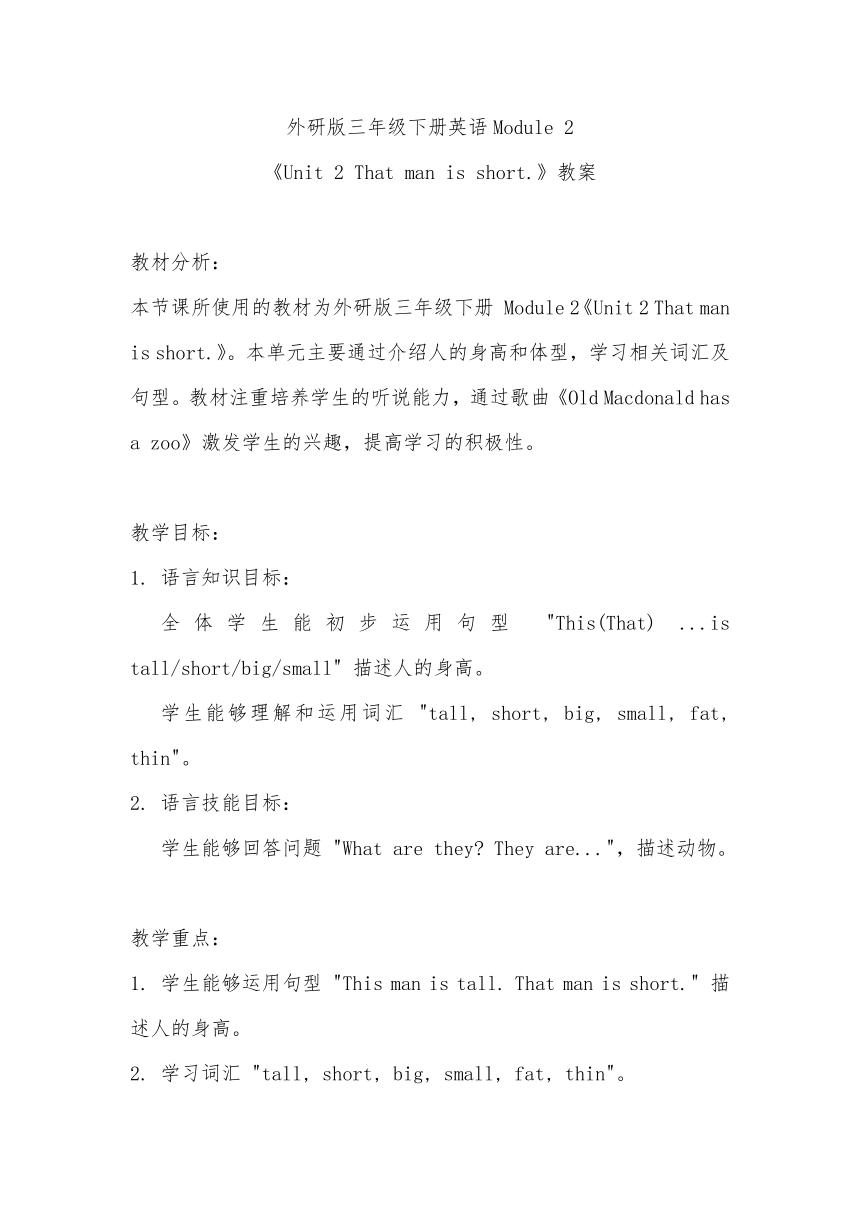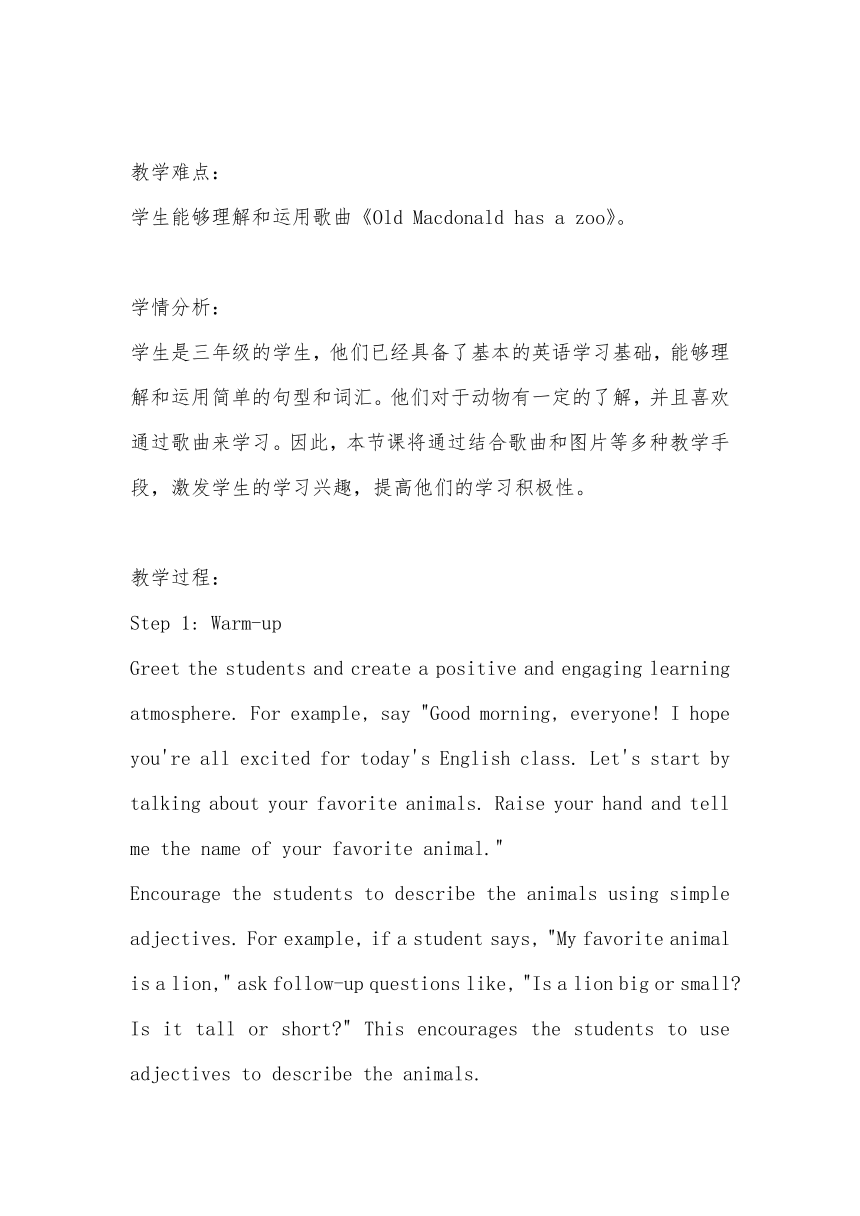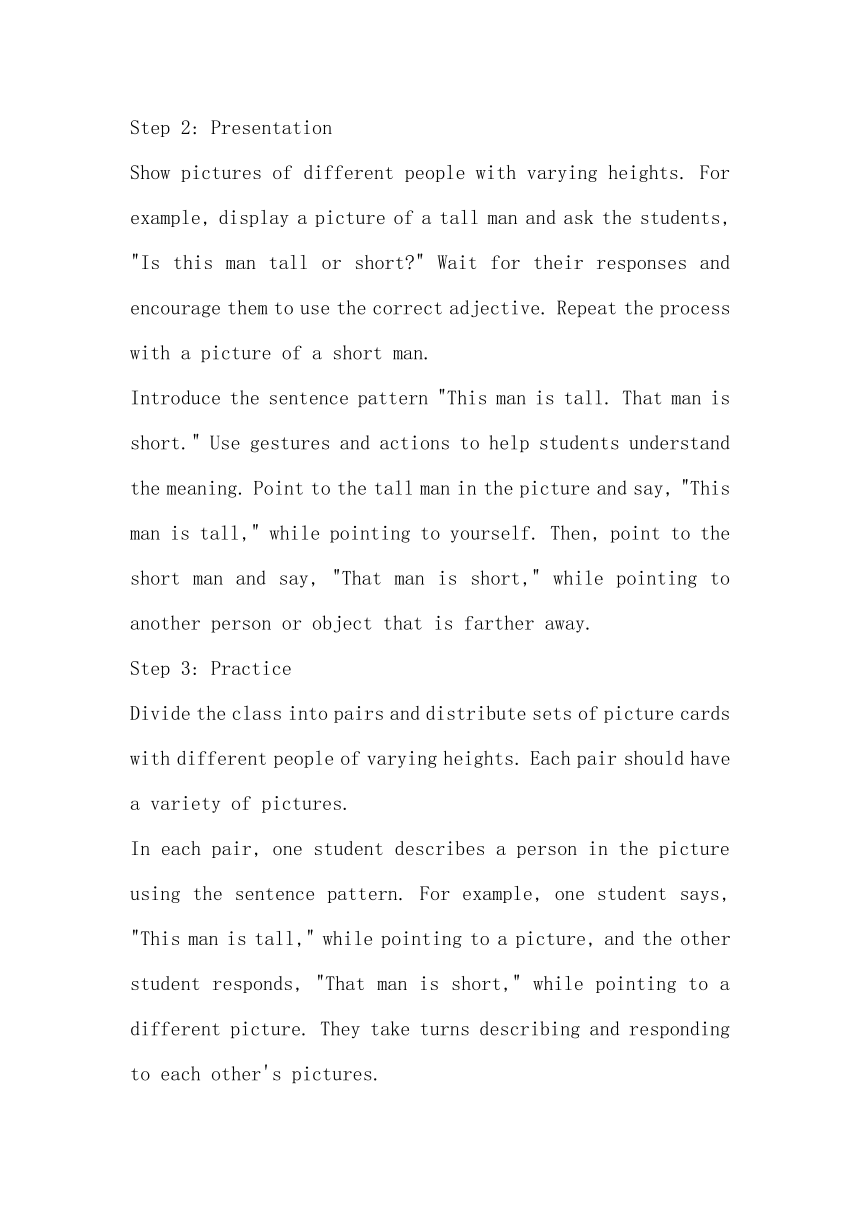Module 2 Unit 2 That man is short.教案
文档属性
| 名称 | Module 2 Unit 2 That man is short.教案 |  | |
| 格式 | docx | ||
| 文件大小 | 13.6KB | ||
| 资源类型 | 教案 | ||
| 版本资源 | 外研版(三年级起点) | ||
| 科目 | 英语 | ||
| 更新时间 | 2024-01-25 07:57:06 | ||
图片预览



文档简介
外研版三年级下册英语Module 2
《Unit 2 That man is short.》教案
教材分析:
本节课所使用的教材为外研版三年级下册 Module 2《Unit 2 That man is short.》。本单元主要通过介绍人的身高和体型,学习相关词汇及句型。教材注重培养学生的听说能力,通过歌曲《Old Macdonald has a zoo》激发学生的兴趣,提高学习的积极性。
教学目标:
1. 语言知识目标:
全体学生能初步运用句型 "This(That) ...is tall/short/big/small" 描述人的身高。
学生能够理解和运用词汇 "tall, short, big, small, fat, thin"。
2. 语言技能目标:
学生能够回答问题 "What are they They are...",描述动物。
教学重点:
1. 学生能够运用句型 "This man is tall. That man is short." 描述人的身高。
2. 学习词汇 "tall, short, big, small, fat, thin"。
教学难点:
学生能够理解和运用歌曲《Old Macdonald has a zoo》。
学情分析:
学生是三年级的学生,他们已经具备了基本的英语学习基础,能够理解和运用简单的句型和词汇。他们对于动物有一定的了解,并且喜欢通过歌曲来学习。因此,本节课将通过结合歌曲和图片等多种教学手段,激发学生的学习兴趣,提高他们的学习积极性。
教学过程:
Step 1: Warm-up
Greet the students and create a positive and engaging learning atmosphere. For example, say "Good morning, everyone! I hope you're all excited for today's English class. Let's start by talking about your favorite animals. Raise your hand and tell me the name of your favorite animal."
Encourage the students to describe the animals using simple adjectives. For example, if a student says, "My favorite animal is a lion," ask follow-up questions like, "Is a lion big or small Is it tall or short " This encourages the students to use adjectives to describe the animals.
Step 2: Presentation
Show pictures of different people with varying heights. For example, display a picture of a tall man and ask the students, "Is this man tall or short " Wait for their responses and encourage them to use the correct adjective. Repeat the process with a picture of a short man.
Introduce the sentence pattern "This man is tall. That man is short." Use gestures and actions to help students understand the meaning. Point to the tall man in the picture and say, "This man is tall," while pointing to yourself. Then, point to the short man and say, "That man is short," while pointing to another person or object that is farther away.
Step 3: Practice
Divide the class into pairs and distribute sets of picture cards with different people of varying heights. Each pair should have a variety of pictures.
In each pair, one student describes a person in the picture using the sentence pattern. For example, one student says, "This man is tall," while pointing to a picture, and the other student responds, "That man is short," while pointing to a different picture. They take turns describing and responding to each other's pictures.
Monitor the students' practice and provide assistance as needed. Offer guidance on pronunciation and encourage them to use the sentence pattern accurately.
Step 4: Vocabulary
Introduce new vocabulary words: big, small, fat, thin. Write the words on the board and explain their meanings using real-life objects or pictures. For example, show a picture of a large elephant to illustrate "big" and a small coin to illustrate "small."
Repeat the words chorally and individually, and encourage students to practice saying the words aloud. You can say each word and have the students repeat after you. Then, ask individual students to say the words independently.
Step 5: Song
Introduce the song "Old Macdonald has a zoo" to the students. Play the song and ask the students to listen carefully. You can play the song once without lyrics and ask the students to pay attention to the melody and rhythm.
Provide the students with the lyrics of the song and go through it together. Explain any unfamiliar vocabulary or expressions in the lyrics. Point out the animal names and their characteristics mentioned in the song, such as "big cow" or "small duck."
Sing the song with the students, focusing on the animal names and their characteristics. Encourage the students to join in and sing along. Use gestures or actions to represent each animal as they sing about it.
Repeat the song several times, gradually reducing the support and encouraging students to sing independently. You can also incorporate movement or dance to make it more interactive and engaging.
Step 6: Consolidation
Ask the students to form small groups and distribute animal picture cards to each group.
In their groups, students take turns showing the picture cards to their group members and describing the animals using the sentence pattern and vocabulary words learned in this lesson. For example, a student can hold up a picture of a lion and say, "This lion is big," while other group members respond, "That lion is small."
Monitor the groups and provide feedback and support as needed. Encourage students to help each other and provide positive reinforcement for their efforts.
Step 7: Wrap-up
Review the key points of the lesson, including the sentence pattern "This man is tall. That man is short" and the vocabulary words: big, small, fat, thin. You can ask questions like, "Can you tell me an animal that is big " or "What is the opposite of 'tall' "
Encourage students to use the new language in their daily conversations and observations. For example, suggest they describe the height or size of people and objects they encounter outside the classroom. Reinforce the importance of practicing English in real-life situations.
板书设计:
Teacher's board
This man is tall. That man is short.
Vocabulary: tall,short, big, small, fat, thin
教学反思:
本节课通过多种教学手段,如图片、句型、词汇和歌曲,帮助学生学习描述人的身高和体型的句型和词汇。学生在课堂上积极参与,能够听懂和运用句型描述人的身高,并能够理解和运用相关的词汇。歌曲的引入激发了学生的学习兴趣,提高了他们的参与度。在练习环节中,学生能够与同伴合作进行对话练习,并能够自主描述动物。整体上,学生在本节课的学习中表现出良好的积极性和合作意识。需要注意的是,在教学过程中要注意给予学生足够的语言输入和输出机会,鼓励他们多进行口语练习,巩固所学知识。同时,对于学生学习歌曲的能力和兴趣,可以在今后的教学中进一步拓展,提供更多的歌曲学习的机会。
《Unit 2 That man is short.》教案
教材分析:
本节课所使用的教材为外研版三年级下册 Module 2《Unit 2 That man is short.》。本单元主要通过介绍人的身高和体型,学习相关词汇及句型。教材注重培养学生的听说能力,通过歌曲《Old Macdonald has a zoo》激发学生的兴趣,提高学习的积极性。
教学目标:
1. 语言知识目标:
全体学生能初步运用句型 "This(That) ...is tall/short/big/small" 描述人的身高。
学生能够理解和运用词汇 "tall, short, big, small, fat, thin"。
2. 语言技能目标:
学生能够回答问题 "What are they They are...",描述动物。
教学重点:
1. 学生能够运用句型 "This man is tall. That man is short." 描述人的身高。
2. 学习词汇 "tall, short, big, small, fat, thin"。
教学难点:
学生能够理解和运用歌曲《Old Macdonald has a zoo》。
学情分析:
学生是三年级的学生,他们已经具备了基本的英语学习基础,能够理解和运用简单的句型和词汇。他们对于动物有一定的了解,并且喜欢通过歌曲来学习。因此,本节课将通过结合歌曲和图片等多种教学手段,激发学生的学习兴趣,提高他们的学习积极性。
教学过程:
Step 1: Warm-up
Greet the students and create a positive and engaging learning atmosphere. For example, say "Good morning, everyone! I hope you're all excited for today's English class. Let's start by talking about your favorite animals. Raise your hand and tell me the name of your favorite animal."
Encourage the students to describe the animals using simple adjectives. For example, if a student says, "My favorite animal is a lion," ask follow-up questions like, "Is a lion big or small Is it tall or short " This encourages the students to use adjectives to describe the animals.
Step 2: Presentation
Show pictures of different people with varying heights. For example, display a picture of a tall man and ask the students, "Is this man tall or short " Wait for their responses and encourage them to use the correct adjective. Repeat the process with a picture of a short man.
Introduce the sentence pattern "This man is tall. That man is short." Use gestures and actions to help students understand the meaning. Point to the tall man in the picture and say, "This man is tall," while pointing to yourself. Then, point to the short man and say, "That man is short," while pointing to another person or object that is farther away.
Step 3: Practice
Divide the class into pairs and distribute sets of picture cards with different people of varying heights. Each pair should have a variety of pictures.
In each pair, one student describes a person in the picture using the sentence pattern. For example, one student says, "This man is tall," while pointing to a picture, and the other student responds, "That man is short," while pointing to a different picture. They take turns describing and responding to each other's pictures.
Monitor the students' practice and provide assistance as needed. Offer guidance on pronunciation and encourage them to use the sentence pattern accurately.
Step 4: Vocabulary
Introduce new vocabulary words: big, small, fat, thin. Write the words on the board and explain their meanings using real-life objects or pictures. For example, show a picture of a large elephant to illustrate "big" and a small coin to illustrate "small."
Repeat the words chorally and individually, and encourage students to practice saying the words aloud. You can say each word and have the students repeat after you. Then, ask individual students to say the words independently.
Step 5: Song
Introduce the song "Old Macdonald has a zoo" to the students. Play the song and ask the students to listen carefully. You can play the song once without lyrics and ask the students to pay attention to the melody and rhythm.
Provide the students with the lyrics of the song and go through it together. Explain any unfamiliar vocabulary or expressions in the lyrics. Point out the animal names and their characteristics mentioned in the song, such as "big cow" or "small duck."
Sing the song with the students, focusing on the animal names and their characteristics. Encourage the students to join in and sing along. Use gestures or actions to represent each animal as they sing about it.
Repeat the song several times, gradually reducing the support and encouraging students to sing independently. You can also incorporate movement or dance to make it more interactive and engaging.
Step 6: Consolidation
Ask the students to form small groups and distribute animal picture cards to each group.
In their groups, students take turns showing the picture cards to their group members and describing the animals using the sentence pattern and vocabulary words learned in this lesson. For example, a student can hold up a picture of a lion and say, "This lion is big," while other group members respond, "That lion is small."
Monitor the groups and provide feedback and support as needed. Encourage students to help each other and provide positive reinforcement for their efforts.
Step 7: Wrap-up
Review the key points of the lesson, including the sentence pattern "This man is tall. That man is short" and the vocabulary words: big, small, fat, thin. You can ask questions like, "Can you tell me an animal that is big " or "What is the opposite of 'tall' "
Encourage students to use the new language in their daily conversations and observations. For example, suggest they describe the height or size of people and objects they encounter outside the classroom. Reinforce the importance of practicing English in real-life situations.
板书设计:
Teacher's board
This man is tall. That man is short.
Vocabulary: tall,short, big, small, fat, thin
教学反思:
本节课通过多种教学手段,如图片、句型、词汇和歌曲,帮助学生学习描述人的身高和体型的句型和词汇。学生在课堂上积极参与,能够听懂和运用句型描述人的身高,并能够理解和运用相关的词汇。歌曲的引入激发了学生的学习兴趣,提高了他们的参与度。在练习环节中,学生能够与同伴合作进行对话练习,并能够自主描述动物。整体上,学生在本节课的学习中表现出良好的积极性和合作意识。需要注意的是,在教学过程中要注意给予学生足够的语言输入和输出机会,鼓励他们多进行口语练习,巩固所学知识。同时,对于学生学习歌曲的能力和兴趣,可以在今后的教学中进一步拓展,提供更多的歌曲学习的机会。
同课章节目录
- Module 1
- Unit 1 It's the ABC song.
- Unit 2 My favourite colour is yellow.
- Module 2
- Unit 1 They are monkeys.
- Unit 2 The man is short.
- Module 3
- Unit 1 I like football.
- Unit 2 I don't like riding my bike.
- Module 4
- Unit 1 Do you like meat?
- Unit 2 Does Lingling like oranges?
- Module 5
- Unit 1 She goes to school on Mondays.
- Unit 2 Does your mum go to work on Saturdays?
- Module 6
- Unit 1 What do you do on Sundays?
- Unit 2 What does Lingling have at school?
- Module 7
- Unit 1 We fly kites in spring.
- Unit 2 It's warm today.
- Module 8
- Unit 1 It's on your desk.
- Unit 2 Daming flies a kite in the park.
- Module 9
- Unit 1 I've got a new book.
- Unit 2 Has Amy got a bike?
- Review Module
- Unit 1
- Unit 2
- Module 10
- Unit 1 Here's a red hat.
- Unit 2 She's got an orange sweater.
